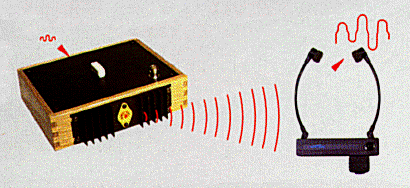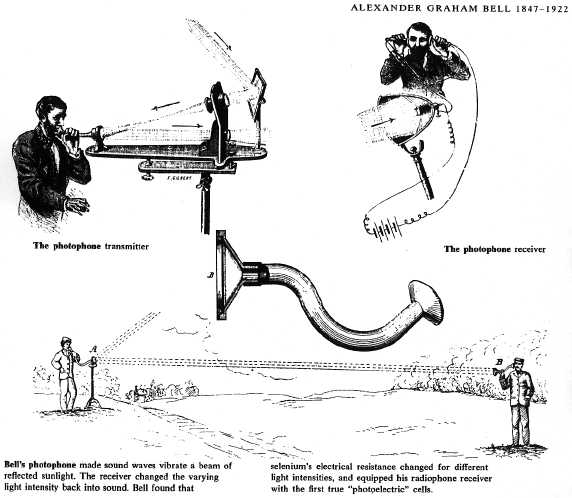
INFORMATION
ABOUT ASSISTIVE LISTENING TECHNOLOGIES
On
this page we will provide background information about
selecting and installing assistive listening systems. This
is a work in progress and not ready for posting yet.
For now, here is a
basic diagram illustrating the operation of our model
SC-186K infrared transmitter's operation.

Sound enters the
microphone, is amplified and processed before being used to
modulate the infrared emitter. The optical signal leaves the
emitter and is picked up by the photodiode on the receiver
which then amplifies the sound before sending it to the
earpiece transducers.
Some Historical Background on the Optical Transmission of
Audio
This has been going on
for a lot longer than most of us realize...

TRANSMITTING SPEECH BY LIGHT BEAMS.
Experiments in the
transmission of speech by means of light beams were first
made by Professor Bell some time ago with an apparatus
called the "Photophone. " The transmitter consisted of a
plain mirror so arranged as to reflect the light upon a
selenium cell in circuit with an ordinary receiver at the
opposite station. The mirror served as a telephone
diaphragm, a resonating chamber and mouthpiece being placed
at the back. Speaking in the mouthpiece vibrated the mirror,
the vibration altering the intensity of the beam of light.
The changes in the light beam resulted in the selenium cell
(acting with its well-known property of altering its
electrical resistance under influence of light) setting up
corresponding changes in the receiver circuit, and so
producing vibrations in the receiver diaphragm like those
communicated to the mirror of the transmitter. Professor
Ruhmen, of Berlin, has improved somewhat on Bell's device,
but the same principle is retained and the system is
successfully used on warships of the German navy. It would
seem as though we now have the germ of a means of
inter-planetary communication.
Excerpted from: The
New Idea Self-Instructor edited by Ferdinand Ellsworth Cary,
A. M. (Monarch Book Company, Chicago & Philadelphia,
1904) p.51
|